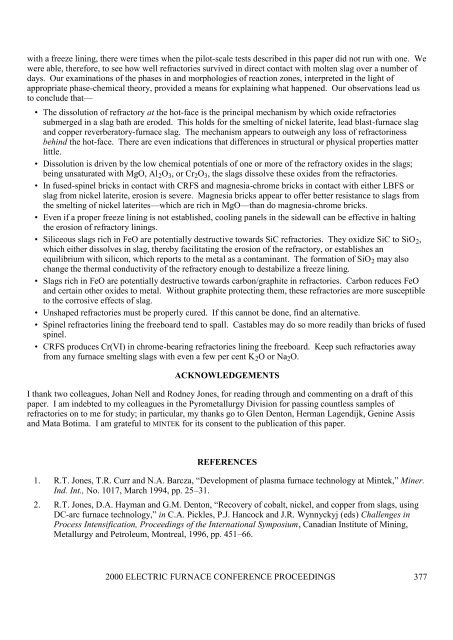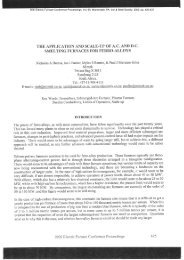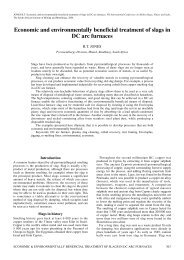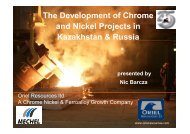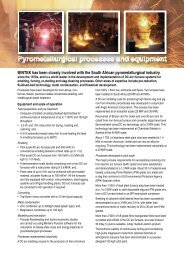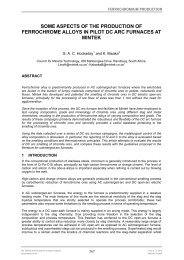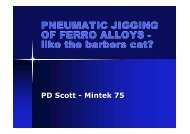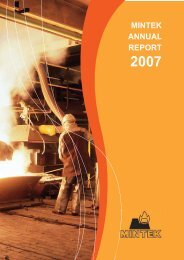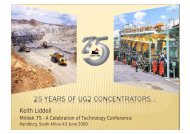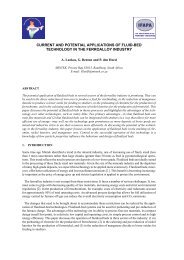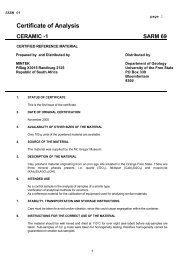Furnace refractory erosion - Mintek
Furnace refractory erosion - Mintek
Furnace refractory erosion - Mintek
Create successful ePaper yourself
Turn your PDF publications into a flip-book with our unique Google optimized e-Paper software.
with a freeze lining, there were times when the pilot-scale tests described in this paper did not run with one. Wewere able, therefore, to see how well refractories survived in direct contact with molten slag over a number ofdays. Our examinations of the phases in and morphologies of reaction zones, interpreted in the light ofappropriate phase-chemical theory, provided a means for explaining what happened. Our observations lead usto conclude that—• The dissolution of <strong>refractory</strong> at the hot-face is the principal mechanism by which oxide refractoriessubmerged in a slag bath are eroded. This holds for the smelting of nickel laterite, lead blast-furnace slagand copper reverberatory-furnace slag. The mechanism appears to outweigh any loss of refractorinessbehind the hot-face. There are even indications that differences in structural or physical properties matterlittle.• Dissolution is driven by the low chemical potentials of one or more of the <strong>refractory</strong> oxides in the slags;being unsaturated with MgO, Al 2 O 3 , or Cr 2 O 3 , the slags dissolve these oxides from the refractories.• In fused-spinel bricks in contact with CRFS and magnesia-chrome bricks in contact with either LBFS orslag from nickel laterite, <strong>erosion</strong> is severe. Magnesia bricks appear to offer better resistance to slags fromthe smelting of nickel laterites—which are rich in MgO—than do magnesia-chrome bricks.• Even if a proper freeze lining is not established, cooling panels in the sidewall can be effective in haltingthe <strong>erosion</strong> of <strong>refractory</strong> linings.• Siliceous slags rich in FeO are potentially destructive towards SiC refractories. They oxidize SiC to SiO 2 ,which either dissolves in slag, thereby facilitating the <strong>erosion</strong> of the <strong>refractory</strong>, or establishes anequilibrium with silicon, which reports to the metal as a contaminant. The formation of SiO 2 may alsochange the thermal conductivity of the <strong>refractory</strong> enough to destabilize a freeze lining.• Slags rich in FeO are potentially destructive towards carbon/graphite in refractories. Carbon reduces FeOand certain other oxides to metal. Without graphite protecting them, these refractories are more susceptibleto the corrosive effects of slag.• Unshaped refractories must be properly cured. If this cannot be done, find an alternative.• Spinel refractories lining the freeboard tend to spall. Castables may do so more readily than bricks of fusedspinel.• CRFS produces Cr(VI) in chrome-bearing refractories lining the freeboard. Keep such refractories awayfrom any furnace smelting slags with even a few per cent K 2 O or Na 2 O.ACKNOWLEDGEMENTSI thank two colleagues, Johan Nell and Rodney Jones, for reading through and commenting on a draft of thispaper. I am indebted to my colleagues in the Pyrometallurgy Division for passing countless samples ofrefractories on to me for study; in particular, my thanks go to Glen Denton, Herman Lagendijk, Genine Assisand Mata Botima. I am grateful to MINTEK for its consent to the publication of this paper.REFERENCES1. R.T. Jones, T.R. Curr and N.A. Barcza, “Development of plasma furnace technology at <strong>Mintek</strong>,” Miner.Ind. Int., No. 1017, March 1994, pp. 25–31.2. R.T. Jones, D.A. Hayman and G.M. Denton, “Recovery of cobalt, nickel, and copper from slags, usingDC-arc furnace technology,” in C.A. Pickles, P.J. Hancock and J.R. Wynnyckyj (eds) Challenges inProcess Intensification, Proceedings of the International Symposium, Canadian Institute of Mining,Metallurgy and Petroleum, Montreal, 1996, pp. 451–66.2000 ELECTRIC FURNACE CONFERENCE PROCEEDINGS 377


